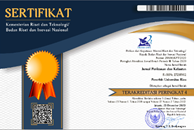Sustainable Tourism Development in Sungai Apit District Riau Province: Mangrove Ecotourism Factors
(1) Jurusan Ilmu Kelautan Fakultas Perikanan dan Kelautan Universitas Riau
(*) Corresponding Author
Abstract
Keywords
Full Text:
PDFReferences
Astuti, D dan T. Widodo. 2018. Identifikasi potensi serta minat konsumen akan ekowisata mangrove di Pulau Bengkalis. Jurnal Inovasi Dan Bisnis. Vol. 6: 135–141.
Febriansyah, F., D. Hartono., B. F. Negara., P. P. Renta and Y. P. Sari. 2018. Structure of mangrove community in Pulau Baii of Bengkulu City. Jurnal Enggano. Vol 3(1): 112–128.
Iswahyudi, I., C. Kusmana., A. Hidayat dan B. P. Noorachmat. 2019. Evaluasi kesesuaian lahan untuk rehabilitasi hutan mangrove Kota Langsa Aceh. Jurnal Matematika Sains dan Teknologi. Vol. 20(1): 45-56.
Joandani, G. K., R. Pribadi dan C . A. Suryono. 2019. Kajian potensi pengembangan ekowisata sebagai upaya konservasi mangrove di Desa Pasar Banggi, Kabupaten Rembang. Journal of Marine Research. Vol. 8(1): 117–126.
Katiandagho B. 2015. Analisis struktur dan status ekosistim mangrove di perairan Timur Kabupaten Biak Numfor. Jurnal Ilmiah Agribisnis dan Perikanan. Vol. 8(1): 8-12.
Mahyoaty. 2015. Pengembangan Ekowisata Mangrove Di Resort Balanan Taman Nasional Baluran. IPB: Departemen Konservasi Sumberdaya Hutan dan Ekowisata.
Mughofar A; M. Mohammad dan S. Prabang. 2018. Zonasi dan komposisi vegetasi hutan mangrove Pantai Cengkrong Desa Karanggandu Kabupaten Trenggalek Provinsi Jawa Timur. Jurnal Pengelolaan Sumberdaya Alam dan Lingkungan. Vol. 8(1):77-85.
Murdiyarso,D., J. Purbopuspito., J. B. Kauffman., M. Warren., S. Sasmito., D. Donato., and S. Kunianto. 2015. The potential of Indonesian mangrove forests for global climate change mitigation. Nature Climate Change. Vol.5.
Nasir, M; Burhanuddin dan I. Dewantara. 2019. Keanekaragaman jenis vegetasi penyusun hutan mangrove di Desa Medan Mas Kabupaten Kubu Raya. Jurnal Hutan Lestari. Vol. 7 (2). P 973-982.
Novianty, F., A. Mulyadi dan Efriyeldi. 2017. Struktur Komunitas Hutan Mangrove Desa Mengkapan Kecamatan Sungai Apit Kabupaten Siak. JOM Faperika, Vol. 4(2), 1–13.
Rangkuti, F. 2018. Analisis SWOT: teknik membedah kasus bisnis cara perhitungan bobot, rating, dan OCAI. Cetakan Keduapuluh Empat. Jakarta: PT Gramedia Pustaka Utama.
Sahami, F. 2018. Penilaian kondisi mangrove berdasarkan tingkat kerapatan jenis. Jurnal Ilmiah Perikanan dan Kelautan. Vol. 6(2): 33-40.
Seliari, T dan Ikaputra. 2021. Ekowisata: utopia dalam keberlanjutan. Jurnal Ilmiah Pariwsata. Vol. 26(2): 193-203.
Suyanto, E., F. Wardiyono, T. Wuryaningsih dan T. R. Widyastuti. 2018. Model Kebijakan Pengelolaan Ekowisata Hutan Mangrove Kampung Laut Segara Anakan. Prosiding Semonar Nasional Dan Call for Paper, November, 8–16.
Tablaseray, V. E., M. R. A. Pairin., N. Fakdawer dan B. Hamuna. 2018. Pemetaan sebaran dan kerapatan mangrove di pesisir Timur Pulau Biak, Papua menggunakan citra satelit Landsat 8. Jurnal Perikanan dan Kelautan. Vol. 8(1): 81-89.
Tidore, S., C. F. A. Sondak., A. P. Rumengan., E. Y. Kaligis., E. L. Ginting dan C. Kondoy. 2021. Struktur komunitas hutan mangrove di Desa Budo Kecamatan Wori Kabupaten Minahasa Utara. Jurnal Pesisir dan Laut Tropis. Vol. 9(2): 71-78.
Yoswaty, D. dan J. Samiaji. 2013. Buku Ajar Ekowisata Bahari. UR Press, Riau. 111 hlm.
Yulianda, F. 2019. Ekowisata perairan suatu konsep kesesuaian dan daya dukung wisata bahari dan wisata air tawar. Bogor: IPB Press.
Article Metrics
Abstract view : 233 timesPDF - 465 times
DOI: http://dx.doi.org/10.31258/jpk.26.3.205-213
Copyright (c) 2021 Jurnal Perikanan dan Kelautan

This work is licensed under a Creative Commons Attribution-NonCommercial-NoDerivatives 4.0 International License.
Gedung Marine Center Lt 2. Fakultas Perikanan dan Kelautan Universitas Riau



